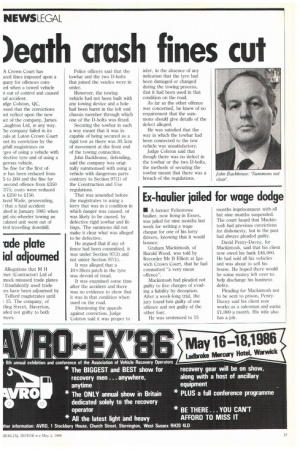)eath crash fines cut
Page 13

If you've noticed an error in this article please click here to report it so we can fix it.
A Crown Court has iced fines imposed upon a ipany for offences corned when a towed vehicle it out of control and caused tal accident.
idge Colston, QC, 'ssed that the convictions lot reflect upon the new ter of the company, James ...aughton Ltd, in any way. 'he company failed in its eals at Luton Crown Court nst its conviction by the pthill magistrates on rges of using a vehicle with !fective tyre and of using a gerous vehicle.
'he fine for the first of:e has been reduced from 5 to 260 and the fine for second offence from £350 175; costs were reduced n £250 to 2150.
)avid Wade, prosecuting, I that a fatal accident ilted in January 1985 when Rid six-wheeler towing an culated unit went out of trol travelling downhill. Police officers said that the towbar and the two D-bolts that joined the veicles were in order.
However, the towing vehicle had not been built with any towing device and a hole had been burnt in the left end chassis member through which one of the D-bolts was fitted.
Securing the towbar in such a way meant that it was incapable of being secured as a rigid tow as there was 30.5cm of movement at the front end of the towing connection.
John Backhouse, defending, said the company Was originally summonsed with using a vehicle with dangerous parts contrary to Section 97(1) of the Construction and Use regulations.
That was amended before the magistrates to using a lorry that was in a condition in which danger was caused, or was likely to be caused, by defective rigid towbar and fittings. The summons did not make it clear what was alleged to be defective.
He argued that if any offence had been committed, it was under Section 97(3) and not under Section 97(1).
It was alleged that a 10 x38cm patch in the tyre was devoid of tread.
It was examined some time after the accident and there was no evidence to show that it was in that condition when used on the road.
Dismissing the appeals against conviction, Judge Colston said it was proper to infer, in the absence of any indication that the tyre had been damaged or changed during the towing process, that it had been used in that condition on the road.
As far as the other offence was concerned, he knew of no requirement that the summons should give details of the defect alleged.
He was satisfied that the way in which the towbar had been connected to the tow vehicle was unsatisfactory.
Judge Colston said that though there was no defect in the towbar or the two D-bolts, the methods of securing the towbar meant that there was a breach of the regulations.






































































